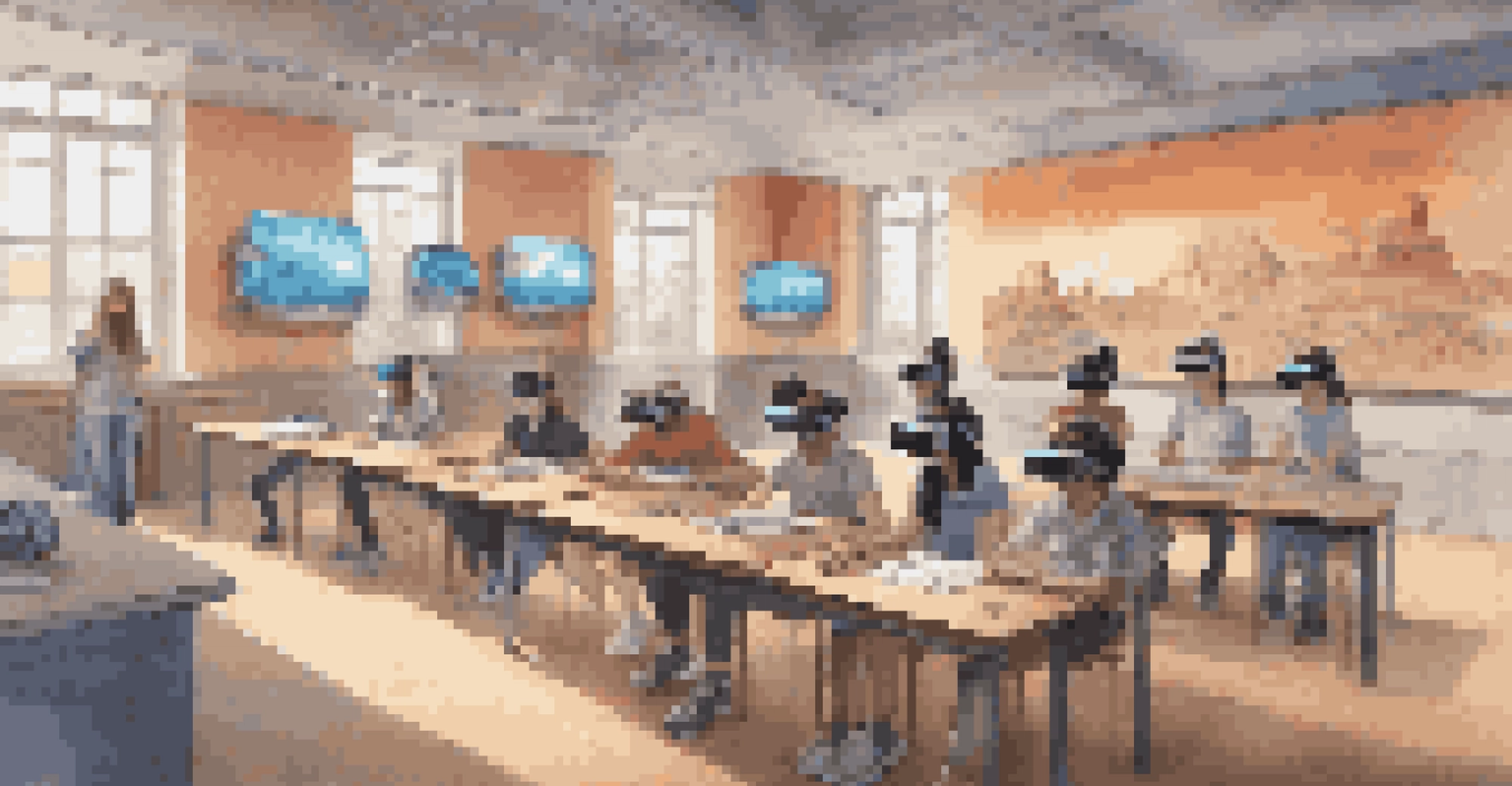AI-Enhanced Learning Pathways: Navigating Student Journeys

Understanding AI in Education: A New Frontier for Learning
Artificial Intelligence (AI) is revolutionizing education by providing innovative tools that cater to individual learning needs. With AI, educators can analyze student performance data to tailor their teaching methods, ensuring that each student's learning journey is as effective as possible. This shift towards personalized education allows for a deeper understanding of each student's strengths and weaknesses.
Artificial intelligence is a tool for people to use, not a replacement for them.
Imagine a classroom where every student has a unique learning plan designed just for them. AI algorithms can identify patterns in student behavior and performance, enabling teachers to make informed decisions about how to support their students. This not only enhances engagement but also fosters a love for learning, as students receive the attention they need to thrive.
As we navigate this new frontier, it's essential to recognize that AI isn't here to replace teachers; rather, it's a powerful tool that complements their expertise. The collaboration between educators and AI can lead to a more enriching educational experience, paving the way for future generations to succeed.
Personalized Learning Pathways: Tailoring Education to Students
Personalized learning pathways are at the heart of AI-enhanced education, allowing students to progress at their own pace. By analyzing data from assessments and interactions, AI can recommend specific resources and activities that align with each student’s unique learning style. This tailored approach not only boosts comprehension but also increases motivation and engagement.

For instance, a student struggling with math concepts can receive targeted exercises and visual aids that simplify complex topics. Meanwhile, another student excelling in the same subject can be challenged with advanced problems, keeping them engaged and excited. This targeted support helps students master skills more effectively than traditional, one-size-fits-all methods.
AI Personalizes Learning Experiences
AI enables personalized learning pathways that adapt to individual student needs, enhancing engagement and comprehension.
Ultimately, personalized learning pathways foster a sense of ownership over one’s education. When students feel that their individual needs are being met, they are more likely to take initiative and responsibility for their learning journey, leading to better outcomes and a more positive overall experience.
AI Tools for Educators: Enhancing Curriculum and Instruction
Educators today have access to a variety of AI tools designed to enhance curriculum and instruction. These tools can automate administrative tasks, freeing up valuable time for teachers to focus on what they do best—teaching. From grading assignments to tracking student progress, AI can streamline processes and provide actionable insights that inform instructional decisions.
The great thing about technology is that it allows us to be more human and more connected.
For example, AI-driven analytics can highlight trends in student performance, helping educators identify areas where students may need additional support. This allows teachers to adjust their instructional strategies proactively, ensuring that no student falls behind. The result is a more dynamic and responsive classroom environment that caters to the diverse needs of all learners.
Moreover, these tools can also assist educators in creating more engaging lessons. By integrating AI into lesson planning, teachers can access a wealth of resources, including multimedia content and interactive activities, that can capture students' interest and enhance their understanding of complex concepts.
Data-Driven Insights: Shaping Student Learning Experiences
Data-driven insights are a crucial component of AI-enhanced learning pathways, as they provide valuable feedback on student performance. By collecting and analyzing data from various sources, including assessments and classroom interactions, educators can gain a clearer picture of each student's journey. This information is vital for making informed decisions about curriculum and instruction.
Imagine being able to pinpoint exactly where a student is struggling and what resources they need to improve. AI can highlight these areas of need, allowing teachers to implement targeted interventions that can lead to significant improvements in learning outcomes. This data-driven approach not only helps students succeed but also enhances overall classroom effectiveness.
Data-Driven Insights Improve Teaching
By analyzing student performance data, educators can make informed decisions that lead to more effective instructional strategies.
However, it’s important to approach data with care, ensuring that privacy and ethical considerations are addressed. Educators must balance the benefits of data-driven insights with the responsibility of safeguarding student information, fostering a trust-based relationship between students, parents, and schools.
The Role of Feedback: Continuous Improvement in Learning
Feedback is an essential element of the learning process, and AI can significantly enhance how feedback is provided to students. Through real-time assessments and analytics, AI tools can deliver instant feedback on assignments, allowing students to understand their mistakes and learn from them immediately. This timely response boosts their confidence and encourages a growth mindset.
For instance, a writing application powered by AI can analyze a student's work and provide suggestions for improvement, from grammar corrections to style enhancements. This kind of personalized feedback helps students refine their skills and develop a deeper understanding of the subject matter. It’s like having a personal tutor available 24/7, guiding them along their learning journey.
Moreover, the continuous feedback loop facilitated by AI not only benefits students but also helps educators refine their teaching practices. By analyzing how students respond to feedback, teachers can adjust their methods and focus on areas that require more attention, ultimately leading to a more effective learning environment.
Fostering Collaboration: AI in Group Learning Environments
AI isn't just about individual learning; it also plays a significant role in fostering collaboration among students. Group learning environments can benefit from AI tools that facilitate communication and teamwork, enabling students to work together more effectively. These tools can help organize group projects, assign roles, and track progress, ensuring that everyone contributes to the final outcome.
For example, AI platforms can analyze each student’s strengths and weaknesses, suggesting optimal group compositions that maximize collaboration. This not only helps students learn from one another but also builds essential social skills that are crucial in today’s interconnected world. Working together on projects can lead to richer discussions and deeper learning experiences.
AI Enhances Collaboration in Classrooms
AI tools facilitate teamwork among students, helping them collaborate effectively and develop essential social skills.
As students collaborate, AI can monitor group dynamics and provide insights into how well the team is functioning. This feedback allows educators to intervene when necessary, helping to cultivate a positive and productive group atmosphere that benefits all participants.
Looking Ahead: The Future of AI in Education
The future of AI in education is promising, with potential advancements that could further enhance the learning experience. As technology continues to evolve, we can expect even more sophisticated tools that can adapt to the changing needs of students and educators. Innovations like virtual reality (VR) and augmented reality (AR) may soon be integrated with AI, providing immersive learning experiences that were once unimaginable.
Imagine students being able to explore historical sites or conduct virtual science experiments right from their classrooms. Such experiences can significantly deepen understanding and engagement, making learning more interactive and enjoyable. The possibilities are endless, and they open up new ways for students to connect with their studies.

However, as we embrace these advancements, it's crucial to maintain a focus on equity and accessibility. Ensuring that all students have access to AI-enhanced learning tools will be vital for creating a more inclusive educational landscape that benefits everyone, regardless of their background.